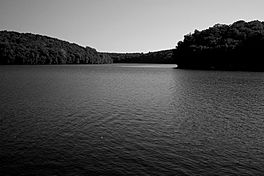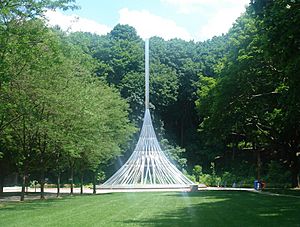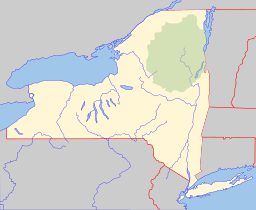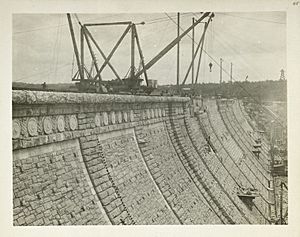Kensico Reservoir facts for kids
Quick facts for kids Kensico Reservoir |
|
|---|---|

Kensico Reservoir
|
|
| Location | Valhalla, Harrison, North Castle, New York, United States |
| Coordinates | 41°5′10″N 73°45′50″W / 41.08611°N 73.76389°W Kensico Dam41°04′25″N 73°45′59″W / 41.07361°N 73.76639°W |
| Type | reservoir |
| Primary inflows | Bronx River |
| Primary outflows | Bronx River |
| Basin countries | United States |
| Surface area | 2,140 acres (8.7 km2) |
| Average depth | 43.6 feet (13.3 m) |
| Max. depth | 120 feet (37 m) |
| Water volume | 30,000,000,000 US gallons (110,000,000 m3) |
The Kensico Reservoir is a huge man-made lake located in New York. It's found near the towns of Armonk and Valhalla. This reservoir is super important because it stores most of the drinking water for New York City.
The first dam here was built in 1885. It collected water from the Bronx and Byram rivers. Later, in 1915, a much bigger dam was built. This new dam helped bring water all the way from the Catskill Mountains, which are over 100 miles (160 km) away! The Kensico Reservoir is about 15 miles (24 km) north of New York City. It's one of only three reservoirs in the Catskill/Delaware water system that's outside the Catskill Mountains.
Besides providing water, the Kensico Reservoir is also a fun place for fishing and boating. Every year, thousands of brown trout are added to the reservoir. For example, in April 2016, over 8,600 brown trout were stocked there.
Contents
Building the Kensico Reservoir
Why New York City Needed More Water
As New York City grew bigger in the 1800s, it needed more and more water. The city first started getting water from Westchester County in 1842, from a place called the Croton Dam. But by the 1880s, even more water was needed. This led to plans for bigger reservoirs, including the Kensico Reservoir.
The Village of Kensico Flooded
The area where the reservoir now sits was once a small village called Kensico. It was named after a Native American chief, Cokenseko. In 1885, a smaller dam was built south of this village to help supply water to New York City. But it still wasn't enough! The city needed a much larger reservoir to hold water from many new sources.
The Kensico area was perfect for a big reservoir because it had hills that formed a natural V-shape. This shape could hold a huge amount of water. Nearby, there was a quarry that provided the stone needed to build the new dam.
However, building the new, bigger reservoir meant the village of Kensico had to be flooded. About 200 people lived there, and the village had homes, stores, churches, and even a train station. All these had to be moved or covered by water.
Preparing for Construction
In 1905, New York State passed laws to allow money to be raised for the Kensico Reservoir project. The next year, planning began. To move building materials, 17 miles (27 km) of private railroad tracks were built. A network of roads was also created. A special camp was built for the workers and their families, complete with schools for their children.
Before construction, every piece of land in the village was bought from its owners. Many families had to move to nearby towns like Armonk, Harrison, Valhalla, and White Plains. Then, the village of Kensico was flooded to create the reservoir.
Dam Construction Details
Work on the current Kensico Dam started in 1913, after the old dam was removed. It was finished in 1917, three years ahead of schedule! The dam is 1,843 feet (562 m) long and stands 307 feet (94 m) tall from its base. It contains a massive amount of stone, similar to some ancient pyramids.
At the peak of construction, about 1,500 men worked on the dam. Many of these workers were Italian immigrants. They had to dig down deep, about 110 feet (34 m), to reach solid rock. This involved a lot of blasting and was very dangerous work. As the dam was built, they laid huge concrete blocks.
The arrival of so many workers brought a lot of business to the local area. New stores, hotels, and restaurants opened. Many of the workers and their families stayed in the area after the dam was finished. This helped the towns of Valhalla and its neighbors grow. Today, the Kensico Dam Plaza is a park managed by Westchester County.
Where Kensico's Water Comes From
The Kensico Reservoir is like a giant collecting pool for water. It gathers water from six other reservoirs in the Catskill Mountains:
- The Ashokan Reservoir
- The Cannonsville Reservoir
- The Neversink Reservoir
- The Pepacton Reservoir
- The Rondout Reservoir
- The Schoharie Reservoir
It also gets water from other reservoirs like the Croton Falls, Muscoot, New Croton, and West Branch reservoirs. This water travels through long tunnels called the Catskill and Delaware aqueducts. Water also comes from nearby Rye Lake.
The Kensico Reservoir itself only provides about 2% of New York City's water. Most of the water comes from the other reservoirs it connects to. The water either goes to New York City or flows down the spillway, continuing into the Bronx River.
The water that goes to New York City travels through either the Catskill Aqueduct or the Delaware Aqueduct. These aqueducts carry the water through different parts of New York City, like The Bronx, Manhattan, Brooklyn, Queens, and Staten Island.
Keeping the Dam Strong
In 2005, the New York City Department of Environmental Protection (DEP) started a big project to fix up the Kensico Dam. This project involved cleaning and repairing all the stone parts of the dam. They also fixed up the buildings and pathways around the dam, and added new lighting. This work helps make sure the dam stays strong and safe for many years.
Fishing at Kensico Reservoir
The Kensico Reservoir is a great place for fishing! It has many types of fish, including brown trout, lake trout, smallmouth bass, largemouth bass, perch, and grass pickerel. Because the reservoir is so big and deep, lake trout especially do very well here.
You can fish from the shore in many areas. If you want to boat, you can only use special aluminum rowboats that are checked by the Department of Environmental Conservation. Motorboats, kayaks, rafts, or canoes are not allowed on the reservoir.
In April 2020, over 7,300 young brown trout were added to the reservoir. Lake trout used to be stocked here too, but that stopped because they now have enough baby lake trout born naturally in the reservoir.
Kensico Dam Plaza: A Public Park

The area around the Kensico Dam is a popular public park called Kensico Dam Plaza. It's a unique spot for many activities. Westchester County often hosts outdoor movies, concerts, and arts and crafts shows here. It's also a nice place for picnics, rollerblading, walking, and enjoying nature.
There are many fun things to do at the Plaza. Every year, there's a big Fourth of July celebration with fireworks, food trucks, and live music. It gets very crowded, so carpooling is a good idea! The streets nearby are closed off for the event. There's also an annual "Winter Wonderland" event with food and ice skating.
The Plaza has a playground and an exercise area for people who like to hike. There are also signs around the Plaza that tell you about the dam's history and suggest fun activities.
Kensico Dam Plaza is also home to "The Rising". This is a special memorial for the victims from Westchester County who lost their lives in the tragic events of September 11, 2001. The memorial lists their names on granite. Its main structure is made of steel rods that point towards the sky. Visitors can even go inside the structure. An annual ceremony is held here to remember those who were lost.
After the events of September 11, 2001, the road across the top of the Kensico Dam was closed to cars for safety reasons. If the dam were damaged, it could affect New York City's water supply and flood many communities. The road was reopened in May 2012, but only for people walking or riding bikes.






